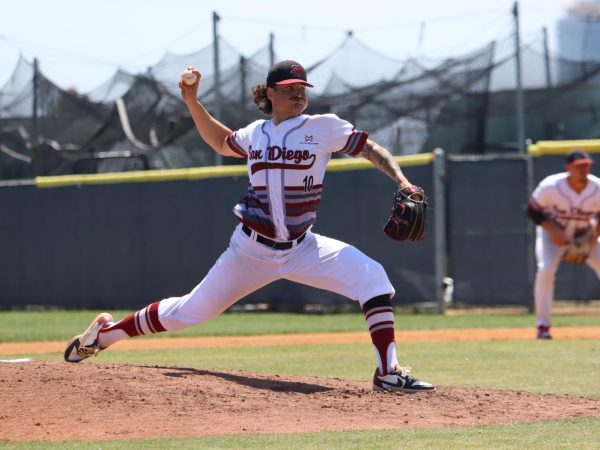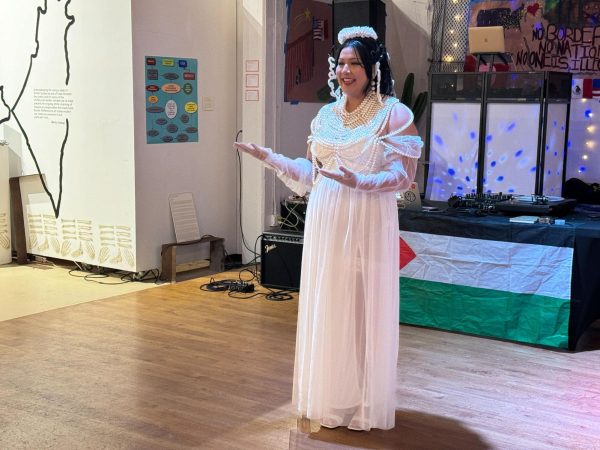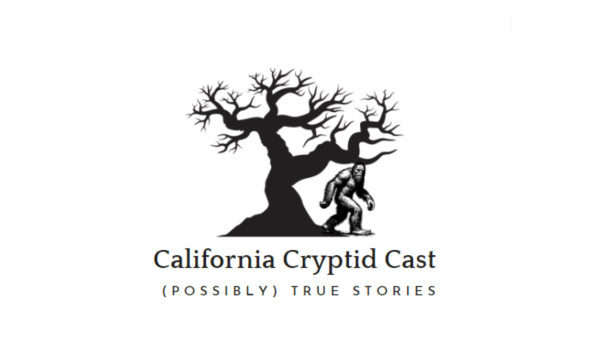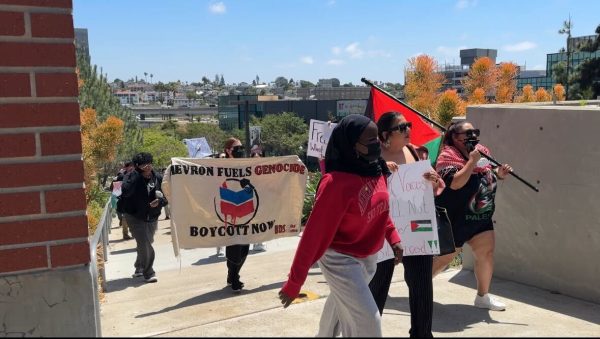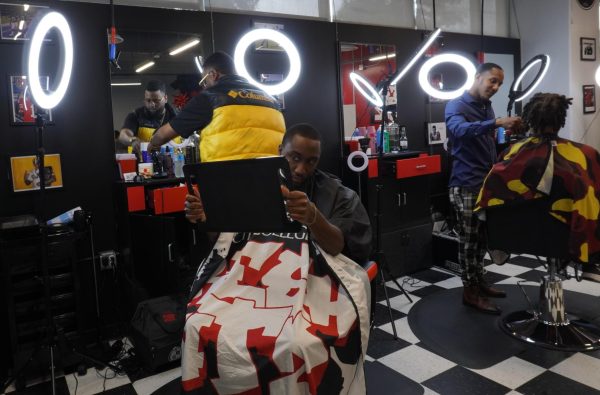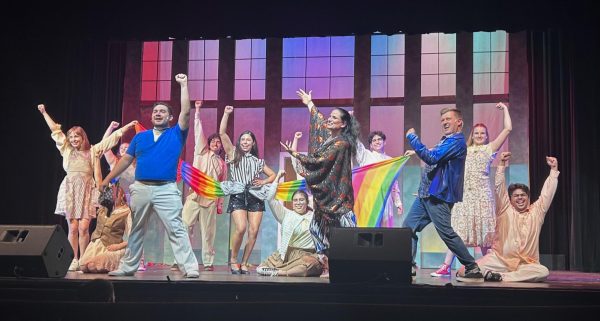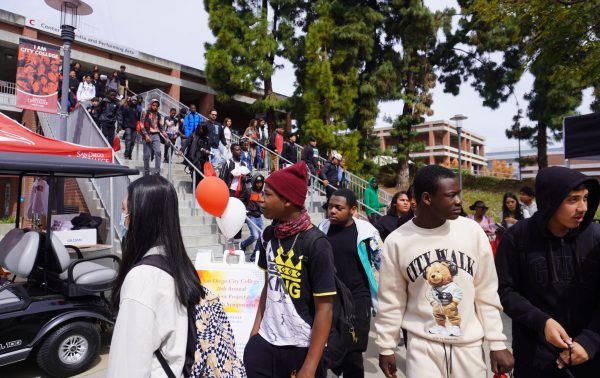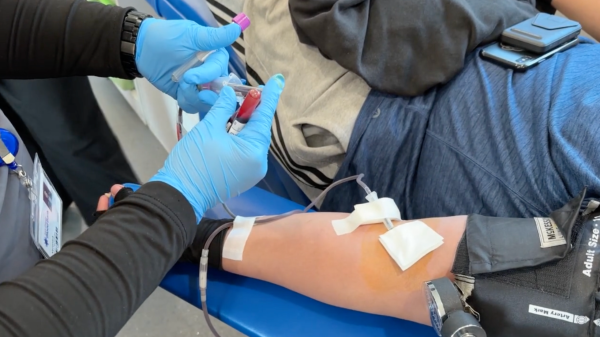Miles apart: Trump visit incites rallies at the border
March 21, 2018
[ngg_images source=”galleries” container_ids=”36″ sortorder=”296,295,297,298,299,300″ display_type=”photocrati-nextgen_basic_imagebrowser” ajax_pagination=”1″ order_by=”sortorder” order_direction=”ASC” returns=”included” maximum_entity_count=”500″]
By nine o’clock on the morning of March 13, law enforcement, spectators and reporters from around the world were ready in place near the Otay Mesa port of entry to witness President Donald Trump’s arrival to San Diego. The morning tour of border wall prototypes was scheduled as the first stop in the president’s first visit to California since he took office last January.
Other than the sound of semi truck traffic crossing through the commercial entry point, the area surrounding the port was surprisingly quiet and calm. Plans for large rallies and protests near the port were promoted on social media and reported by local news the day before, but at the time the events were scheduled to begin, less than a dozen spectators were present.
The location chosen for Trump’s arrival and the security measures in place made it nearly impossible for large crowds to gather that morning. The arrival point was surrounded by a business-industrial park with limited public parking, and since the nearest roads were blocked off by police barricades, demonstrators were forced to walk about a mile to the meeting place. In addition to road closures, San Diego County Sheriff’s Department announced a temporary ban on a list of items “considered as an implement of riot” in the area where demonstrations were expected, which included poles, sticks, dowels and boards used for flags, signs and banners.
The sterile atmosphere and tightened security were in sharp contrast to Trump’s last visit to San Diego in May 2016, when demonstrations against then-candidate Trump’s speech at the Convention Center erupted in violence. San Diego Police said the protests resulted in 35 arrests, 18 people needing medical care, and two people hospitalized.
Police securing the area repeated to inquiring citizens that they had no information about when the president would arrive. Within a half hour, demonstrators shared communication of organized gatherings growing further away from the Otay port, and most chose to move on rather than wait to see Trump arrive.
At 10 a.m., supporters of Trump gathered to rally in an empty lot at the corner of Bristow Court and Britannia Boulevard, about four miles from the Otay port. The event was organized by San Diegans for Secure Borders, along with San Diego Patriots, Fight Sanctuary State.com, The Remembrance Project, and drew representatives from other political and social organizations, including controversial white-supremacist group Identity Evropa.
The group was easily distinguished by dense cluster of American flags flying above, as well as stars and stripes printed on an array of clothing and accessories. The bright patriotic colors stood out against a grey background of concrete industrial buildings and an overcast sky, seeming to symbolize the crowd’s hyped-up energy.
The red “Make America Great Again” hats made famous during the 2016 presidential election were also popular in the crowd, adding to the feeling of a campaign-style rally. One man seen wearing this hat was Lance Rogers of the Kern County town of Ridgecrest, California, who said he attended the rally, “to support Trump and make some money for myself.” Rogers has been selling Trump merchandise, including the top-selling red hat, at pro-Trump rallies since 2016, and said that business is good. Rogers said he’s been to over 50 rallies across the United States, and smiled as he humorously said, “going to rallies is a lot like going to concerts. It’s kinda the same crowd showing up to support all over.” Rodgers gave an A grade to President Trump’s first year in office for his work on the economy, jobs, and building the border wall.
While the main issue of the rally was border security, the speakers repeatedly pumped up the crowd with more general excitement over President Trump’s victory in the 2016 election.
Author and political activist Trevor Loudon addressed the crowd by first explaining the German concept of schadenfreude, the feeling of pleasure derived from witnessing another person’s misfortune, and then asked, “Did anyone else feel a little schadenfreude on the day after the election when you saw those snowflakes with tears in their eyes, crying like it was the end of the world?” The crowd erupted with cheering and laughter.
At noon, a significantly larger crowd gathered at Our Lady of Mt. Carmel Catholic church in San Ysidro to express opposition to the border wall. The event brought together leaders of the interfaith community, social justice and political action groups including San Diego Women’s March and San Diego Organizing Project, ACLU, labor union organizers, as well as local political leaders Assemblywoman Lorena Gonzalez and Congressman Juan Vargas.
Former City College student Damian Vergara attended the rally as a volunteer for one of the event’s main organizers, Border Angels. Vergara, who is now a PhD student at Yale University, said he was motivated to volunteer with Border Angels because of impact of the organization’s projects, which include dropping life-saving supplies along the dangerous desert routes used to cross from Mexico to the U.S. Vergara explained that he grew up with undocumented status in San Diego, and now volunteers to support the immigrant community because he believes, “Migration is a human right. People should be allowed to move across borders safely, without threatening their life or facing legal persecution.” Border Angels contributed dozens of wooden crosses to the rally for demonstrators to carry, each symbolizing one of over 10,000 migrants estimated to have died attempting to cross the border since 1994.
Others attending the rally saw this as an opportunity to publicly oppose President Trump for a wide variety of issues beyond the border wall. Hannah Usher was one of many in attendance who represented the Women’s March movement by wearing a commemorative t-shirt from the 2017 march. Usher explained that the rally against the wall was a way for her to continue the activism that was first sparked by the Women’s March. Since the 2016 election, she said she’s challenged herself to speak up more on divisive issues, including the border wall and gender equality. She said these conversations have been especially difficult in the workplace, given that her industry is dominated by white males who often do not share her perspective. Usher added, “I’ve been scared for my job a little bit. It’s hard, but you know, you gotta say something. They know why I’m not at work right now, I can say that.”


